Hedhvick Hirav
Hedhvick Hirav is a dedicated EV researcher and editor with over 4 years of experience in India’s growing electric vehicle ecosystem. Their contributions have been recognized in leading sustainability publications and automotive journals.
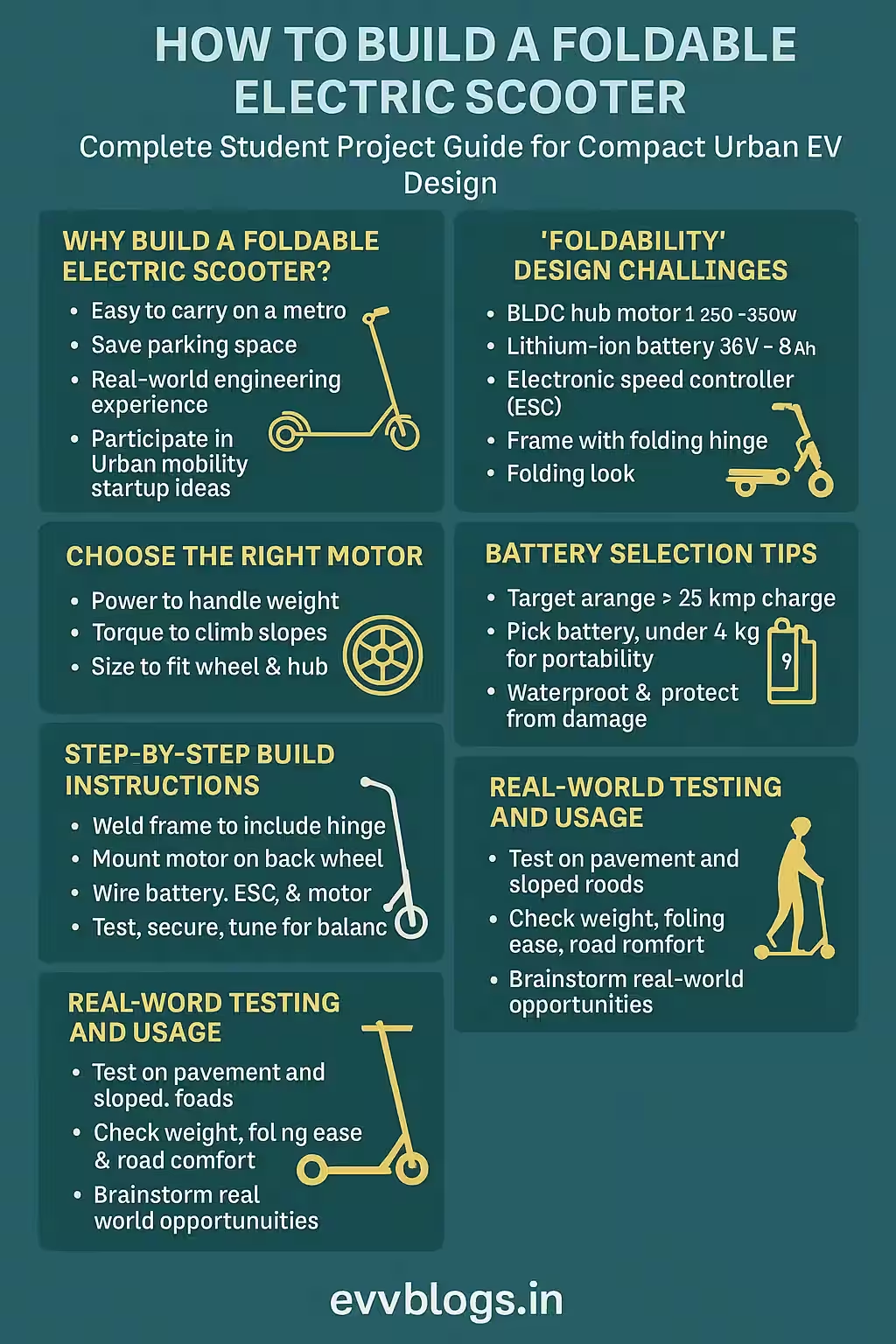
What is a Foldable Electric Scooter and Why Should You Build One in India in 2025?
Electric scooters are transforming the way you travel in Indian cities. A foldable electric scooter is a compact, battery-powered two-wheeler that you can easily fold and carry. They’re lightweight, eco-friendly, and perfect for crowded places like metro stations, colleges, and office parks.
A student project to build your own foldable electric scooter is exciting and helps you understand EV technology, electronics, and mechanical design—skills that are in high demand in India’s job market for 2025.
- Foldable electric scooters can be carried in buses, metros, or even stored under your desk.
- They run on rechargeable lithium-ion batteries, common in Indian EVs today.
- Building one is cost-effective compared to buying a new branded model.
- India’s EV ecosystem is rapidly growing, making parts and knowledge more accessible.
Who should build one?
- College students for engineering or science projects.
- Hobbyists interested in DIY mobility.
- Anyone wanting to explore EV technology hands-on.
Did You Know?
India’s electric two-wheeler market is expected to cross 6 million units by 2025, with foldable scooters being the fastest-growing segment for urban use. (Source: FADA India Report 2025)
Which Materials and Components Do You Need for a DIY Foldable Electric Scooter in India?
Before you start building, it’s important to collect all materials and components. Most are available online via Indian e-commerce (Amazon, Flipkart) or at local hardware and electronics markets.
Key Parts Needed:
- Frame: Light but sturdy material like aluminium alloy or mild steel.
- Electric Motor: Typically between 250W to 500W BLDC motor for city use.
- Battery Pack: 36V or 48V Lithium-ion battery (Indian ISI-approved).
- Controller: Compatible with your motor and battery.
- Folding Mechanism: Hinges, clamps, and locking pins.
- Wheels & Suspension: 8–10-inch rubber wheels, basic suspension for Indian roads.
- Brakes: Disc or drum brakes (safety is priority).
- Throttle: Twist or thumb type, electronic.
- Display: Simple LCD or LED for battery level, speed, distance.
- Wiring & Connectors: Good quality, heat-resistant.
- Charger: Suitable for your battery type, ISI marked.
Extra Materials:
- Paint or powder coating for rust protection.
- Reflectors & lights for safety.
- Side stand, mudguards (for Indian monsoons).
Expert Insight
Always choose ISI-marked batteries and chargers to meet the Government of India’s safety standards for electric vehicles in 2025.
How Much Will It Cost to Build a Foldable Electric Scooter in India (2025)?
Building a foldable electric scooter yourself in India is much cheaper than buying a branded model, but costs can vary depending on your choices.
Estimated Budget Breakdown (2025):
| Component | Cost in INR (Approx) | Details |
|---|---|---|
| Frame (Aluminium) | 2,000 – 4,000 | Lightweight, rust-proof |
| BLDC Motor (250-500W) | 3,500 – 6,000 | Indian brands available |
| Lithium Battery (36V/48V) | 7,000 – 16,000 | ISI-certified, 15–30km range |
| Controller | 1,000 – 2,500 | With safety features |
| Wheels & Suspension | 1,500 – 3,500 | Suitable for Indian roads |
| Brakes | 800 – 2,000 | Disc preferred |
| Throttle & Display | 800 – 1,800 | Digital or analog |
| Wiring/Connectors | 400 – 1,000 | Good quality, heat-resistant |
| Charger | 1,500 – 2,500 | Fast charging preferred |
| Miscellaneous | 2,000 – 4,000 | Folding, paint, lights, etc. |
| Total (approx.) | 20,000 – 43,000 | Based on quality and features |
- Local sourcing can reduce costs further.
- You can upgrade parts (battery, display) for premium features.
- Labour cost is nil if you assemble yourself.
What Tools and Skills Do You Need to Build Your Electric Scooter?
You don’t need to be an expert, but some basic skills and tools are necessary.
Essential Skills:
- Basic electrical wiring and soldering.
- Mechanical assembly (nuts, bolts, drilling).
- Reading simple wiring diagrams.
- Using hand tools safely.
Tools Checklist:
- Screwdrivers (various sizes)
- Wrenches and Allen keys
- Electric drill with bits
- Soldering iron and wire stripper
- Multimeter (for voltage/current testing)
- Pliers, cutters, and hammer
- Measuring tape and marker
- Safety gloves and goggles
Learning Resources:
- YouTube: “DIY electric scooter India” channels
- Coursera, Udemy: Short EV engineering courses
- Indian student forums and maker communities
Did You Know?
Many Indian engineering colleges now have EV clubs and workshops, providing students with free access to labs and mentors for projects like this.
How to Design a Foldable Electric Scooter Frame for Indian Roads?
The frame is the backbone of your electric scooter. In India, you need a design that handles potholes, speed breakers, and varied weather.
Key Design Points:
- Use aluminium alloy for lightness and durability.
- Ensure the folding joint is sturdy and lockable—test with your body weight.
- Allow space inside the frame for battery and wiring.
- Design footboard with anti-slip surface (PVC, rubber).
- Plan for a handlebar that folds down easily for compactness.
Step-by-Step:
- Draw a simple sketch with all measurements (handlebar height, wheelbase).
- Mark folding hinge placement for easy folding/unfolding.
- Keep ground clearance at least 100 mm for Indian bumps.
- Include attachment points for brakes, throttle, and lights.
Pro Tips:
- Use modular design so you can upgrade parts later.
- Test folding/unfolding 20–30 times to ensure reliability.
Expert Insight
Indian summer heat (up to 48°C) can weaken joints; always use high-quality fasteners and test for thermal expansion.
Which Battery and Motor Should You Choose for Your Scooter in 2025?
Battery and motor selection is crucial—they decide speed, range, and safety.
Best Options for India (2025):
- Battery: 36V 10Ah or 48V 15Ah Lithium-ion, ISI-certified, 800+ charge cycles.
- Motor: 250W for short distance/campus, 500W for city commutes (BLDC recommended).
Selection Criteria:
- Choose battery with in-built BMS (Battery Management System) for safety.
- Higher Ah = longer range (aim for 20–30km per charge for city use).
- BLDC motors are efficient, low-maintenance, and weather-resistant.
Indian Brands and Availability:
-
Okaya, Exide, Amaron are reliable for batteries.
-
BLDC motors available from local vendors or online (Robu.in, Amazon India).
-
Always match motor power with battery voltage.
-
Motor and battery should be waterproof, as per Indian monsoon conditions.
Did You Know?
As per the FAME-II scheme (Faster Adoption and Manufacturing of Hybrid and Electric Vehicles), using Indian-made batteries and motors can qualify you for future government incentives.
How Do You Assemble the Scooter – Step-by-Step?
Building your scooter is a rewarding process! Here’s a practical assembly guide suitable for Indian students:
Step 1: Frame Assembly
- Attach wheels to the frame with suspension.
- Fix the handlebars and folding hinge securely.
Step 2: Motor and Battery Installation
- Mount the BLDC motor near the rear wheel (chain or hub motor setup).
- Secure the battery inside the frame or on the deck, ensuring it’s well-protected.
Step 3: Electrical Wiring
- Connect the battery, controller, motor, and throttle as per the wiring diagram.
- Use proper insulation and route wires away from moving parts.
Step 4: Accessories and Safety
- Install brakes, headlight, taillight, horn, and reflectors.
- Fix the display panel and test throttle response.
Step 5: Testing
- Test all functions at low speed: acceleration, braking, folding, and unfolding.
- Check for unusual sounds, overheating, or loose parts.
- Charge battery fully before first ride.
Safety First:
- Wear helmet and gloves during test rides.
- Never bypass battery BMS or use uncertified chargers.
Expert Insight
Indian universities encourage team projects—team up with friends to divide tasks and finish faster!
Which Regulations, Licenses, and Safety Standards Apply in India (2025)?
In 2025, electric scooters face clear rules in India. Here’s what you need to know before using your scooter on public roads:
Legal Aspects:
- Electric scooters with speed below 25 km/h and power below 250W do not need registration or driver’s license (Central Motor Vehicle Rules 2025).
- Above these limits, RTO registration and basic insurance are mandatory.
- ISI certification is a must for battery and charger.
Safety Standards:
-
Must have working headlight, taillight, horn, and reflectors.
-
Brakes should be efficient and well-calibrated.
-
Emergency cut-off switch recommended.
-
Follow local state guidelines as rules may vary (e.g., Delhi, Maharashtra, Karnataka have stricter policies).
Disclaimer:
These rules are updated regularly by the Ministry of Road Transport and Highways (MoRTH). Always check latest notifications before riding on public roads.
Did You Know?
Indian EV policy updates in 2025 may introduce new subsidies for student projects using “Made in India” components.
How Does Your DIY Foldable Electric Scooter Compare with Market Leaders in India (2025)?
It’s smart to compare your build with top brands to set realistic expectations and identify areas to improve.
| Feature | DIY Build | Ather 450S | Ola S1 Air | Simple Dot One | Bounce Infinity E1 | Hero Electric Optima | Okinawa Lite | TVS iQube | Yulu Wynn | Pure EV EPluto 7G | Bajaj Chetak |
|---|---|---|---|---|---|---|---|---|---|---|---|
| Price (INR, 2025) | 20,000–43,000 | 1,25,000 | 1,00,000 | 1,10,000 | 75,000 | 95,000 | 70,000 | 1,15,000 | 69,999 | 89,000 | 1,40,000 |
| Foldable Design | Yes | No | No | No | Yes | No | Yes | No | Yes | No | No |
| Motor Power (W) | 250–500 | 540 | 450 | 750 | 1500 | 250 | 250 | 750 | 250 | 220 | 3800 |
| Battery (V/Ah) | 36/10 or 48/15 | 48/21 | 48/21 | 48/21 | 48/20 | 48/28 | 48/24 | 52/23 | 48/17 | 60/2.5 | 50.4/60.4 |
| Range (km) | 20–30 | 65 | 100 | 160 | 85 | 70 | 60 | 100 | 68 | 90 | 108 |
| Top Speed (km/h) | 25–35 | 80 | 85 | 105 | 65 | 25 | 25 | 78 | 24 | 60 | 63 |
| Weight (kg) | 18–22 | 108 | 99 | 110 | 94 | 68 | 60 | 118 | 82 | 76 | 100 |
| Portable Charger | Yes | Yes | Yes | Yes | Yes | Yes | Yes | Yes | Yes | Yes | Yes |
| Warranty | DIY—Own | 3 yrs | 3 yrs | 3 yrs | 2 yrs | 3 yrs | 3 yrs | 3 yrs | 2 yrs | 3 yrs | 3 yrs |
| Service Network | Self/Friends | Yes | Yes | Yes | Yes | Yes | Yes | Yes | Yes | Yes | Yes |
| License Required | No (<250W/25kph) | Yes | Yes | Yes | Yes | No | No | Yes | No | No | Yes |
| Customizable | Fully | Limited | Limited | Limited | Limited | Limited | Limited | Limited | No | Limited | Limited |
| DIY Fun & Learning | Maximum | Low | Low | Low | Medium | Low | Medium | Low | Medium | Low | Low |
In-Depth Details for Each Option
- DIY Build: Highly customizable, lowest cost, foldable, not for high-speed commuting, best for learning and short city trips.
- Ather 450S: Advanced tech, fast charging, long range, heavy, expensive, not foldable.
- Ola S1 Air: Popular, good range, digital features, not foldable, needs license.
- Simple Dot One: High range and speed, best for long commutes, not foldable, high cost.
- Bounce Infinity E1: Portable, battery swapping, limited foldability, economical.
- Hero Electric Optima: Reliable, affordable, basic features, not foldable.
- Okinawa Lite: Light, semi-foldable handlebar, entry-level, short range.
- TVS iQube: High tech, good after-sales, heavy, not foldable.
- Yulu Wynn: Urban mobility, foldable, shared mobility focus, short range.
- Pure EV EPluto 7G: Decent range, affordable, basic design, not foldable.
- Bajaj Chetak: Classic styling, best build, heavy, expensive, not foldable.
By building your own, you maximize learning and portability, but may fall short on speed, range, and warranty compared to top brands.
Did You Know?
Yulu Wynn and Bounce Infinity are the only major Indian brands providing foldable or modular scooters in 2025, mainly for last-mile urban mobility.
What Are the Real Stories and Experiences of Indian Students Who Built Foldable EV Scooters?
Learning from real projects will help you avoid common mistakes and inspire your journey.
Case Study 1: IIT Madras Student Project (2024–2025)
- Team built a foldable e-scooter for campus mobility.
- Used recycled laptop batteries, reducing project cost by 40%.
- Faced issues with frame durability—solved by switching to 6061 aluminium.
- Won a national innovation award; prototype now used by students on campus.
Case Study 2: DIY Hobbyist from Pune
- Built a foldable e-scooter for short commutes to metro.
- Sourced parts from local market, total cost under INR 24,000.
- Added custom digital display using Arduino.
- Issues: battery overheating during summer—fixed by adding vent holes.
Case Study 3: College Engineering Team, Bangalore
- Focused on lightweight design for women users.
- Used ABS plastic and aluminium mix for weight reduction.
- Participated in Smart India Hackathon, got mentorship from industry experts.
- Learned importance of proper waterproofing for monsoon use.
Lessons from User Stories:
- Always test battery and electronics in real Indian weather conditions.
- Collaborate with your college’s EV or robotics club for guidance.
- Document every step—can help win innovation contests or get internships.
Expert Insight
Sharing your project online (YouTube, LinkedIn) can attract recruiters from leading EV companies in India like Ola Electric, Ather, and TVS in 2025.
What are the Common Challenges and Solutions When Building a DIY Electric Scooter in India?
Most Indian students face the same hurdles, but here’s how you can tackle them effectively.
Typical Challenges:
- Difficulty sourcing reliable, ISI-certified batteries.
- Poor road conditions damaging wheels or suspension.
- Overheating of battery/motor in extreme heat.
- Inadequate waterproofing causing short circuits during monsoon.
- Lack of expert guidance for wiring and assembly.
Recommended Solutions:
- Always buy batteries and chargers from certified Indian vendors.
- Use solid rubber or tubeless tyres for durability.
- Add vents or heat sinks to battery/motor enclosure.
- Seal wiring joints with heat-shrink tubes and waterproof tape.
- Join local maker spaces or online forums for Q&A support.
Did You Know?
In 2025, several Indian states (like Tamil Nadu, Delhi) offer grants to student EV projects that showcase practical solutions for local challenges.
How Can You Upgrade or Customize Your Scooter After Building?
Personalization is one of the best reasons to build your own scooter.
Popular Upgrades:
- Bigger battery for longer range (ensure frame can accommodate).
- Bluetooth or IoT module for smart tracking via your smartphone.
- Upgraded suspension for smoother ride on Indian roads.
- Custom paint job or stickers for unique look.
- Integrated solar charging panel (great for college campuses).
- Swappable battery design for convenience.
Customization Ideas:
- Foldable basket or luggage rack for daily use.
- Anti-theft alarm and GPS tracker.
- Add mobile charging port via simple USB converter.
Safety Upgrades:
- Install rear-view mirrors.
- High-decibel horn for busy Indian streets.
- Extra bright LED headlight for night rides.
Always test each upgrade carefully, especially if electrical.
Expert Insight
Indian EV hackathons often reward the most innovative customizations—document your process to boost your CV or college credits!
When is the Best Time to Start Your Foldable Electric Scooter Project in India?
Timing your project right means you can get maximum learning and support.
Best Times to Start:
- Summer vacations: More free time, easier to get college lab access.
- Just before college project submission deadlines.
- Before major student competitions or hackathons.
Why Start in 2025?
-
Indian EV market is booming, with more accessible local parts.
-
Government policies (like FAME-II) are more student-friendly.
-
Colleges and companies are seeking EV talent for internships and jobs.
-
More online tutorials, guides, and community support than ever before.
-
Check with your professors or local industry mentors.
-
Budget 2–3 months for design, sourcing, assembly, and testing.
Did You Know?
Starting your project in 2025 gives you access to the latest high-efficiency batteries and IoT modules at lower prices, thanks to India’s expanding EV manufacturing base.
Conclusion: Should You Build a Foldable Electric Scooter as a Student Project in India in 2025?
Building your own foldable electric scooter is one of the most rewarding projects for Indian students in 2025. You’ll gain hands-on experience in EV technology, mechanical and electrical design, and problem-solving—all essential for India’s future workforce.
- You save money (project cost is 40–70% less than buying a branded EV).
- You can customize for your needs—commute, fun, or even competition.
- Learn real-world skills and boost your job/internship chances in the booming Indian EV sector.
- Stay eco-friendly and develop a practical solution for India’s urban transport challenges.
Final verdict:
If you are an Indian student with basic technical skills and passion, building a foldable electric scooter in 2025 will give you an unbeatable combination of knowledge, savings, and career advantage. It’s not just a project—it’s your passport to India’s green mobility revolution!
FAQs: How to Build a Foldable Electric Scooter – Complete Student Project (2025 India Edition)
Q1. Do I need a driver’s license to ride my foldable electric scooter in India in 2025?
If your scooter’s top speed is under 25 km/h and motor is less than 250W, no license is needed as per current 2025 rules. Always check local RTO regulations.
Q2. Can I get government support or grants for my student project?
Yes, several Indian states have EV innovation grants for students. Check with your college innovation council and the FAME-II portal for opportunities.
Q3. Where can I source affordable, ISI-certified batteries in India?
Look for vendors like Okaya, Exide, and Amaron, or visit electronic markets in your city. Always check for ISI certification for safety.
Q4. What kind of maintenance does a DIY foldable electric scooter need?
Regularly check and tighten bolts, inspect wiring, test brakes, and keep battery charged. Replace worn-out tyres and service moving parts monthly.
Q5. Can I use my DIY foldable electric scooter for daily city commuting?
Yes, for short distances (under 10km), but avoid highways or rough roads. Always wear safety gear and follow traffic rules.
Disclaimer:
This article is for educational purposes. Always follow official guidelines, use ISI-certified parts, and consult qualified professionals for critical electrical work. Building and using DIY vehicles on public roads may require compliance with local laws.


